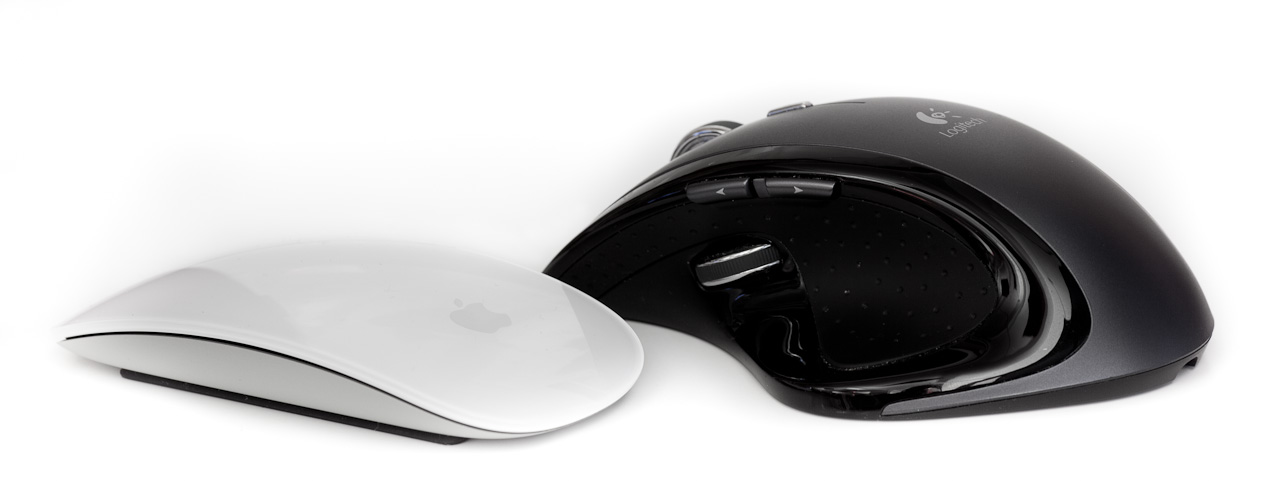https://marco.org/2009/11/13/the-new-magic-mouse-left-replacing-my-huge

The new Magic Mouse, left, replacing my huge, awesome, but flaky MX Revolution.
I didn’t want to like this mouse.
Apple’s previous mice haven’t quite agreed with me. The Mighty Mouse, and the ball-less, no-button wonder before it, seemed to put form over function in the worst, Steve-Jobs-glass-laptop-screen way.
The MX Revolution after a year
Logitech’s premium mice follow the opposite design paradigm: make a big honking thing full of buttons and wheels with 13 different functions. The MX Revolution is a great mouse for many reasons, but the real revolution was the weighty, flywheel-like scroll wheel that moves in the normal notchy, incremental way unless you flick it quickly, at which point it unlocks from notchy mode and free-spins until stopped. This is an amazingly useful and intuitive function when scrolling through very long content, like a long web page, large documents, or an iPhoto library.
But it comes with a cost. Setting the auto-unlock wheel mode requires the Logitech software, which screws with the standard OS X pointer sensitivity and scrolling acceleration. To get mine to work the way it should, I had to install Logitech’s software to enable the auto-unlock wheel, uninstall it, and install SteerMouse instead to enable most other functionality.
In addition to the software complexity, a more fatal flaw with the MX Revolution at my work computer drives me crazy: at least once per day, the mouse becomes unresponsive for a few seconds, then reactivates at factory defaults with no auto-unlock wheel and no button mappings. These features only reactivate if I unplug and replug its USB receiver, a procedure that I’ve now become quite good at performing. I had a warranty replacement sent from Logitech, but it has other strange issues and a completely different-feeling and less-precise scroll wheel, so I don’t use it. In addition, the MX Revolution in my home setup has started suffering from quirky behavior.
With three different MX Revolutions flaking out in three different ways, I was ready for a change. But the auto-unlock wheel is so helpful in my everyday tasks that I didn’t want to give it up.
The Magic Mouse
Fortunately, Apple provided an alternative with the Magic Mouse. Inertia scrolling, optional but enabled by default, makes the scrolling continue slightly after you stop the scrolling gesture, similar to scrolling views on the iPhone.
I tried a Magic Mouse and was very impressed, so I took the risk and bought one. So far, only two days in, I love it. Inertia scrolling is intuitive and well-executed, and I can use it just like I used the MX Revolution’s auto-unlocking wheel: flick quickly to scroll a lot, tap to stop.
It’s tiny, which seems like it would be an issue with comfort or ergonomics. So far, it hasn’t been.
Beyond scrolling, I haven’t used any of the touch gestures yet. I suspect that attempting to do them on a mouse, which is likely to move itself and your pointer while you perform each gesture, is less convenient than performing them on a bigger, flatter, stationary trackpad. (I don’t use the non-scrolling gestures on the laptop trackpads, either.)
It still has the inconvenient behavior of Apple’s recent mice that requires you to lift your left finger off of the mouse in order to right-click. This hasn’t been a huge problem for me, although I have accidentally sent a left-click event when I intended a right-click a few times.
Time will tell how reliable it is. It seems solid so far, but it’s only been two days.
And it provides huge advantages in simplicity: no software, no USB dongle, no charging cradle, no buttons, no wheels. With just one big surface on top and two thin low-friction rails to make contact with the desk on the bottom, it’s even easy to clean.
So far, it’s surprisingly good, and I’m finally going to unplug and pack away my tragically flaky MX Revolutions.